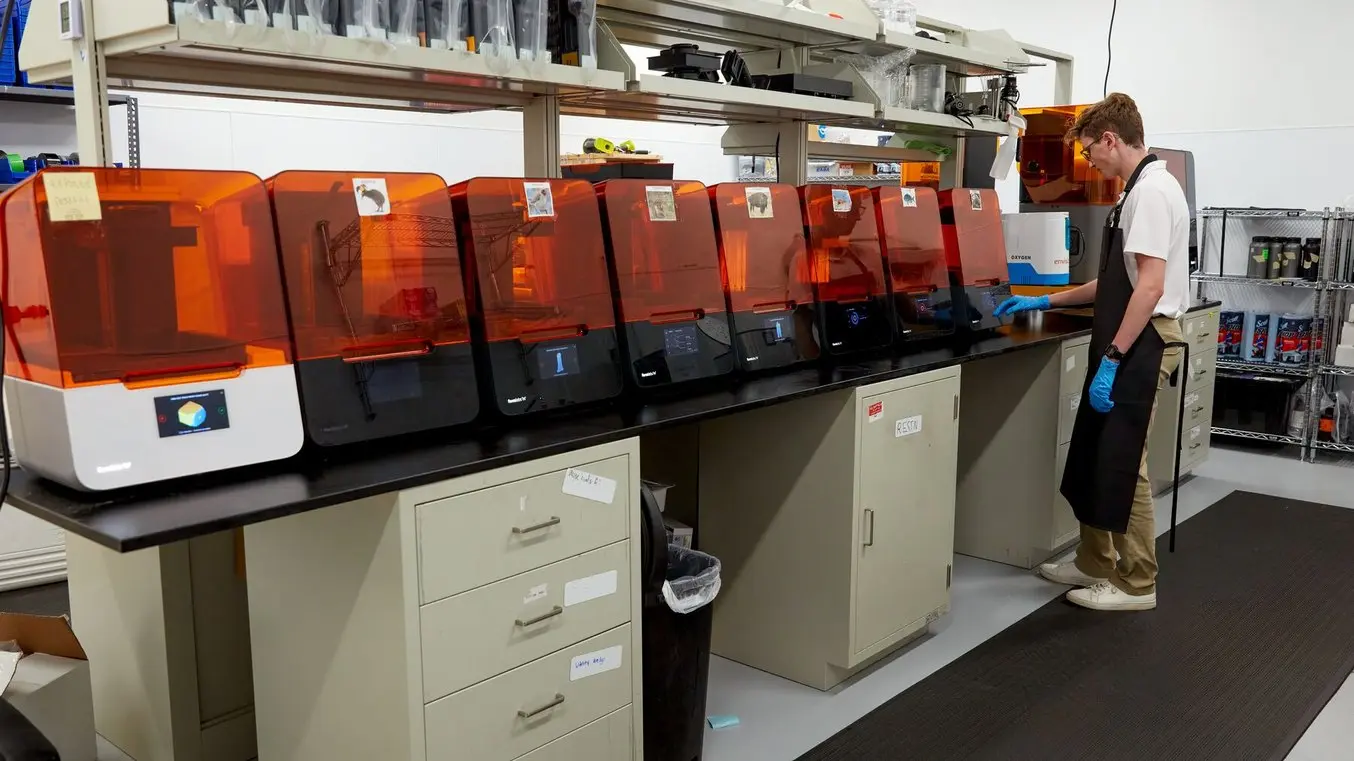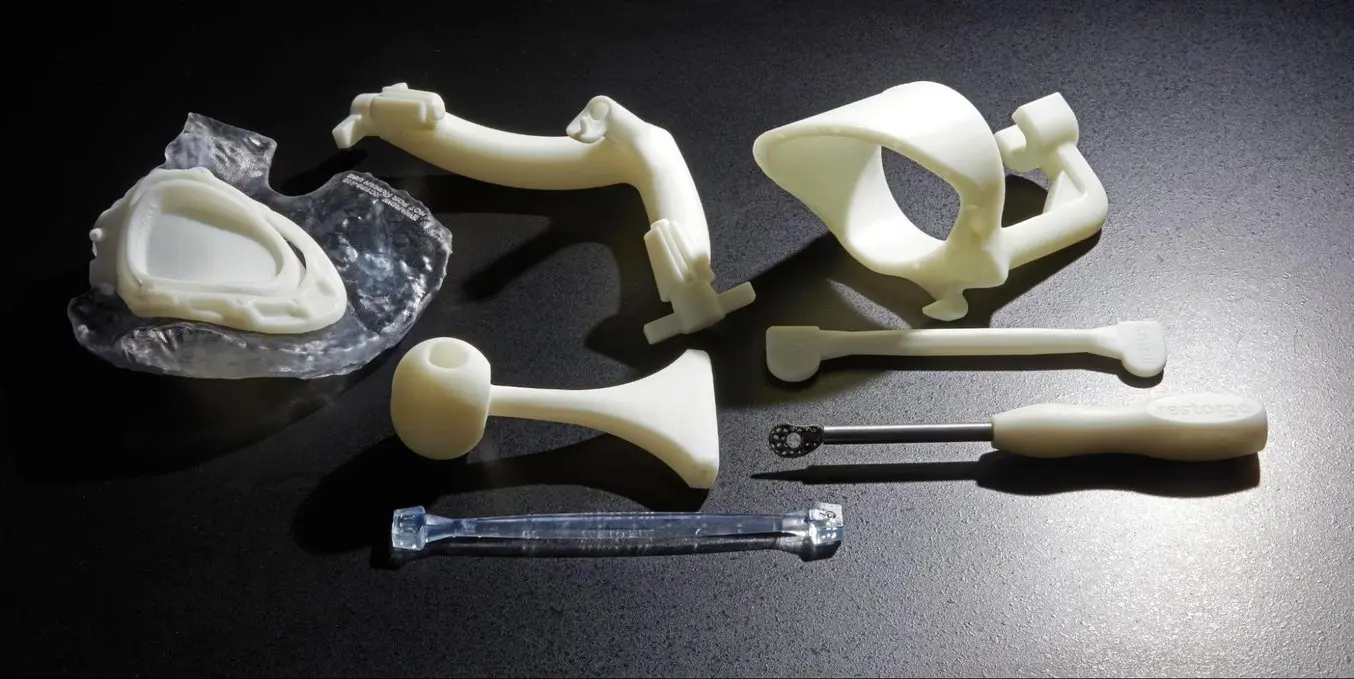For years, the surgical landscape has remained relatively unchanged, with many of the same tools and methods still in use. However, a shift is on the horizon. Orthopedic surgeries have struggled with expensive stainless steel tools, and there’s a growing need to address each patient’s unique anatomy. While several companies are exploring advancements in this arena, restor3d stands out. Collaborating with Formlabs, restor3d uses 3D printing to craft patient-specific surgical instruments. This innovation not only offers an alternative to the traditional surgical tools that can cost up to $50,000 per tray but also raises a pressing question: “With the emergence of patient-specific solutions, why should surgeries still rely on a one-size-fits-all approach?”
With traditional instrument trays machined from stainless steel, costs can skyrocket. The old methods have kept hospitals stuck with outdated techniques. Instead, restor3d relies on a fleet of 25 Formlabs 3D printers to produce the next wave of surgical tools, which are tailored to specific procedures and individual patients, with benefits such as significantly reduced supply chain expenses.
One of the critical components in this transformation is biocompatibility. Formlabs offers medical device firms multiple biocompatible stereolithography (SLA) and selective laser sintering (SLS) materials. Specifically, Formlabs designs its BioMed Resins for medical professionals who seek high-performance, biocompatible materials for diverse applications. An ISO 13485-certified facility manufactures these materials, ensuring their quality and compatibility with standard disinfection and sterilization methods.
Nathan Evans, Senior Vice President of Product Development at restor3d, highlights working with such a supplier expedites market entry by circumventing lengthy and costly biocompatibility tests: “When a supplier has approvals and testing already in place for biocompatibility, for example, ISO 10993 testing, that is really helpful, particularly for an early stage startup, when you might be looking to avoid the super long lead times associated with that testing as well as all the costs. Having that testing in place does allow us to get to market faster and also allows us to justify only doing certain endpoints and not the full gamut of testing. That is a vital thing with Formlabs.”
Used to their traditional training, many surgeons have been hesitant about new technologies. However, seeing colleagues succeed with new tools is changing this. Erik Westerlund, a spine surgeon and director of the Hughston Spine Outcomes Lab at Hughston Clinic Orthopaedics in Georgia, says he is highly impressed with the first-generation anterior cervical discectomy with fusion (ACDF) system created by the restor3d team.
“The current development process has been the same for the last 20 years. A company has a new implant and/or instrument system. The company shows up, does some prototyping, and a few days or weeks later, there is something to look at. Several weeks later, a beta instrument shows up. But now, restor3D isn’t turning out a prototype in a few weeks, they’re turning out the real instrument in a few days. To me, that completely changes what is possible,” explains Westerlund.
Breakthrough in 3D Printed Tools
Scalability is another game-changer for restor3d. Boasting an array of metal 3D printers, the company crafts tooling and implants in cobalt, chrome, and titanium alloys. Within their extensive facility is a fleet of Form 3B+ Formlabs printers tasked with producing single-use instruments and patient-specific devices. Formlabs’ scalable solution allows restor3d to grow its manufacturing capabilities alongside demand.
“The two reasons we have stuck with Formlabs are production flexibility and the ability to incrementally scale,” says Cambre Kelly, Chief Technology Officer at restor3d. “The investment into a Formlabs printer is significantly less than investing half a million dollars to buy one metal printer. So over time, we can continue to tack on to our Formlabs fleet as we need to scale incrementally and do so in a sustainable way that doesn’t require a huge capital investment upfront.”
restor3d’s approach in orthopedic oncology emphasizes collaboration. Since every surgery in this field is unique, quick adjustments using 3D printing based on surgeons’ feedback have significantly impacted. The planning stage is crucial, especially given the differences in each patient’s body. Using Formlabs 3D printers helps make this planning more accurate. This careful approach shortens surgery time, reduces radiation risk, and speeds up patient recovery.
Surgical Precision Evolved
But restor3d isn’t stopping there. They are setting the benchmark in 3D printing for the operating room. From its pioneering preoperative planning kit to its end-to-end solution for instrumentation, they are equipping hospitals with tools to minimize costs and elevate patient care. restor3d recently moved to a larger office to support growth in their current products and develop new specialties. Focused on upcoming developments, Kelly reveals expansion plans into foot and ankle operations, spinal surgeries, and even broader orthopedic applications: “We’re really positioning ourselves to support addressing problems all across the body and with multiple segments of medicine.”
“There are a handful of companies using 3D printing in orthopedics, but few insource entirely. Insourcing enables us to be the fastest product on the market. Our new facility in Durham, North Carolina, solidifies our vision of overseeing the entire production process,” indicates Ben Wesorick, restor3d Vice President of Patient Specific Engineering.
As medical technology evolves, there’s a growing emphasis on individualized care. The partnership between restor3d and Formlabs illustrates the potential of 3D printing in offering patient-specific surgical solutions. The move from a traditional “one-size-fits-all” methodology in surgeries towards more tailored tools and procedures represents a clear answer to the earlier question: There’s no longer a compelling reason for surgeries to rely solely on a universal approach when customization can offer better outcomes. The innovations by these companies suggest that the surgical landscape is changing in favor of individualized care.
Subscribe to Our Email Newsletter
Stay up-to-date on all the latest news from the 3D printing industry and receive information and offers from third party vendors.
You May Also Like
3D Printing News Briefs, April 27, 2024: Research, Digital Dentistry, Cycling, & More
We’re starting today’s 3D Printing News Briefs with some research into 3D printed luminescent quantum-dot polymer architectures and free-form laser beam shaping, and then on to an open source 4-axis...
HP & INDO-MIM Collaborate to Boost Metal 3D Printing in India
HP Inc. and INDO-MIM, a US- and India-based supplier of metal injection molding (MIM) powders and contract manufacturer, have announced that the two companies will collaborate to accelerate additive manufacturing...
3D Printing News Briefs, February 17, 2024: Shot Blasting, Service Bureaus, & More
In today’s 3D Printing News Briefs, we’re starting out with post-processing, as SKZ Würzburg is using a shot blast system from AM Solutions for its research. Moving on to business,...
3D Printing News Unpeeled: Not That Kind of Organ 3D Printing
GKN Aerospace will create a 150 jobs in Trollhattan Sweden with an investment of $60 million part of which comes from the Swedish Energy Agency’s Industriklivet initiative. The investment will...

































